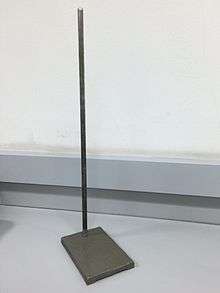Retort stand

A retort stand, sometimes called a clamp stand or a ring stand,[1] is a piece of scientific equipment, clamps can be attached to hold other pieces of equipment. For instance, burettes, commonly used for titration experiments, test tubes and flasks. Retort stand is a general piece of lab equipment that can be used to help with holding other equipments and glasswares. For the pieces of metalware such as ring clamps, versatile clamps, 3-prongs clamp, and burette clamps can be attached to retort stands to better hold certain types of glassware.[2]. The basic retort stand consists of two main pieces of metalware. And those are the retort metallic base and retort
Structure
There are two different models for the retort stand. The base size can be 200 x 125 mm along with a rod of 600 x 12.5 mm. And for the second model, the base will be 250 x 160 mm along with the rod size that will be 750 x 12.5 mm. The bases always have the hole tapped of 10 mm x 1.5 mm.[3] as a swirling hole, that is in order to twist the rod into it. The rod itself, to which clamps may be attached with bases, is typically from 400-600 mm high in total and sufficient for most experiment to fit within the fume hoods and glove boxes. The rod is made out of aluminium. If a taller rod is required, the solid base is usually replaced by three metal legs for stability when supporting larger apparatus, such as extremely large tubes, bulk chemical bottles and etc. The height can be adjusted by moving the attached point of the stand and the test tube. The base is heavy so that the centre of gravity is reduced and there would be some increasing of stability.
Usages
Retort stands are often used in the chemistry laboratory. For instance, it is used for carrying out distillation experiments which includes distillation of organic solvents. It is also used to support in filtering. The sits are usually made of a chemically impervious metal and may be covered with aluminium foil to further protect the base, on which may sit a hot plate, magnetic stirrer, heating mantle, or some other apparatus. In titration experiments, it can be used to hold a burette.
Additional images
 Ringstand with a ring clamp
Ringstand with a ring clamp Ringstand with a burette clamp
Ringstand with a burette clamp Steel rod
Steel rod
References
- ↑ "Ring Stand". Archived from the original on 2016-03-04. Retrieved 2013-04-02.
- ↑ "Ring Stands". www.orgchemboulder.com.
- ↑ "GENERAL LABORATORY METALWARES & GLASSWARES, ETC" (PDF).
| Wikimedia Commons has media related to Retort stand. |